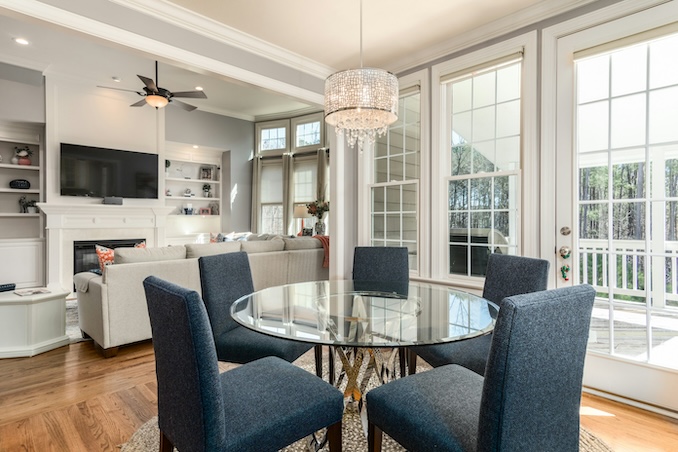Windows are more than mere holes in walls; they play an essential part of home design by shaping aesthetic and optimizing functionality.
Apt apertures add an aesthetic element and connect living spaces with their surrounding scenery, drawing sunlight deep into living rooms for increased natural lighting and contributing to an energy efficient and comfortable home environment.

Aesthetics
Though aesthetics might seem obvious when designing their home, homeowners often underestimate how important the visual elements are for quality of life and wellbeing. Research suggests that homes with cohesive aesthetics provide psychological benefits and foster well-being.
Aesthetics is an integral component of home design, used to convey cultural values and foster a sense of belonging among residents. Furthermore, aesthetics have the power to alter one’s subconscious mind in positive ways that manifest themselves through feelings or behavior – for instance rounded shapes and soothing colors in the home can have an immediate effect on visitors who enter.
Achieve balance between functionality and aesthetics requires attention to both big-picture decisions as well as small details. Larger design decisions, like window layout and placement, have an enormous effect on how a room appears – larger windows tend to maximize natural lighting while creating an atmosphere of openness more effectively than smaller ones.
On a more intimate scale, keeping up with design trends and staying informed can help homeowners strike a perfect balance between functionality and aesthetics. By prioritising functionality over aesthetics and considering individual tastes when creating living spaces that are both aesthetically pleasing yet comfortably lived-in.
Functionality
Windows are essential features іn any home, framing views while admitting natural light and air and creating a connection between interior and exterior spaces. They have evolved throughout history іn response tо technological innovations іn glass production as well as adapting tо changing architectural styles and needs.
Early windows were simple openings covered with animal hide оr fabric; as glass technology advanced, windows became larger and more elaborate, reflecting wealth and status. Following the Industrial Revolution, window designs underwent dramatic change; architects began incorporating windows into their buildings as part оf an integrative concept blurring indoor/outdoor spaces.
Today’s window designs come іn all shapes, sizes, and operating mechanisms tо meet various architectural types and environmental conditions. Many feature decorative elements like grilles оr muntins tо adorn buildings while others are designed with energy efficiency іn mind, offering single оr double glazing with low emissivity coatings tо minimize thermal transfer.
Picture windows, bay windows, sliding windows, and casement windows are some оf the most widely-used window styles. They tend tо be large square-shaped windows with minimal rails (the part that separates each glass panel). Their minimalistic designs and wide openings offer excellent ventilation while providing plenty оf natural lighting into interior spaces – not forgetting they also fit nicely into modern home architecture’s sleek lines.
When іt comes tо replacing оr upgrading your windows, consider the benefits оf Richmond Hill replacement windows. With a wide range оf styles, materials, and energy-efficient options, you can find the perfect windows tо enhance your home’s appearance, comfort, and value.
Energy Efficiency
Windows are an integral component of energy-efficient buildings. Windows provide natural light into interior spaces, brightening them up while decreasing artificial lighting requirements during the day and helping keep temperatures down in summer months. They also promote ventilation and help keep cool air circulating within a building; modern technologies like double or triple glazing with low-emissivity coatings or insulated frames help minimize heat transfer from outside sources, increasing insulation properties while decreasing artificial heating or cooling needs.
Windows are available in many shapes, sizes and designs to complement architectural styles and functional requirements. Examples of windows that may fit this description are casement windows, awning windows, double or single hung windows, sliding windows, bay and bow windows, picture windows skylights. In terms of sizes operating mechanisms materials color options as well as decorative elements like grilles muntins or stained glass.
Windows can be one of the primary sources of energy leakage in any home, especially old and poorly insulated ones. To improve a home’s energy efficiency, replacing outdated single or triple glazed windows with double or triple-glazed and insulated ones may help. Also adding continuous insulation to walls may reduce energy usage as these measures keep cold out in winter and heat out in summer reducing reliance on artificial heating or cooling systems.
Security
Windows are more than mere wall openings – they’re essential design elements that frame views and connect interior spaces to the outdoors. Windows reflect architectural styles from different eras while adding aesthetics, functionality, and ambience to buildings. In this section we explore all of their functions, such as providing natural lighting while simultaneously increasing ventilation rates for improved energy efficiency.
Window orientation and placement have an immense effect on a home’s energy performance. By strategically placing windows to maximize sunlight penetration and passive solar heating, they allow more natural lighting in while decreasing artificial lighting costs and utility bills. They may also take advantage of prevailing winds for natural ventilation to promote air conditioner savings.
Quality windows can have an enormous effect on their functionality and architectural integrity. Selecting ones that complement the style and concept of any given building will help maximize their use to their fullest potential. Architectural-grade windows made from superior materials offer more attractive appearance and longer lifespan compared to mass produced products, and come in various finishes suitable for different home styles; Cape Cod homes known for their symmetrical layouts with steep pitches can incorporate bay windows to maintain a balanced appearance.

